Novel Coordination Polymer of Cadmium (II) with L-Tryptophan
Abstract
1. Introduction
2. Materials and Methods
2.1. Materials
2.2. Methods
3. Results and Discussion
3.1. Crystal Structure Determination
3.2. Hirshfeld Surface Analysis
4. Conclusions
Author Contributions
Funding
Acknowledgments
Conflicts of Interest
References
- Hu, G.; Li, N.; Zhang, Y.; Li, H. A novel pH sensor with application to milk based on electrochemical oxidative quinone-functionalization of tryptophan residues. J. Electroanal. Chem. 2020, 859, 113871. [Google Scholar] [CrossRef]
- Tömösi, F.; Kecskeméti, G.; Cseh, E.K.; Szabó, E.; Rajda, C.; Kormány, R.; Szabó, Z.; Vécsei, L.; Janáky, T. A validated UHPLC-MS method for tryptophan metabolites: Application in the diagnosis of multiple sclerosis. J. Pharm. Biomed. Anal. 2020, 185, 113246. [Google Scholar] [CrossRef] [PubMed]
- Wang, Q.; Qin, G.; Cao, M.; Chen, R.; He, Y.; Yang, L.; Zeng, Z.; Yu, Y.; Gu, Y.; Xing, W.; et al. A phosphorylation-based switch controls TAA1-mediated auxin biosynthesis in plants. Nat. Commun. 2020, 11, 679. [Google Scholar] [CrossRef] [PubMed]
- Mahmoud, M.E.; Osman, M.M.; Abdel-Aal, H.; Nabil, G.M. Microwave-assisted adsorption of Cr(VI), Cd(II) and Pb(II) in presence of magnetic graphene oxide-covalently functionalized-tryptophan nanocomposite. J. Alloy. Compd. 2020, 823, 153855. [Google Scholar] [CrossRef]
- Tandon, P.; Jin, Q.; Huang, L.; Song, R.; Shan, A. Effects of Tryptophan Along with Sodium Pyruvate and Sodium Thiosulfate on Chlorella vulgaris Growth. Waste Biomass Valorization 2019, 11, 967–982. [Google Scholar] [CrossRef]
- Bougherra, H.; Berradj, O.; Adkhis, A.; Amrouche, T. Synthesis, characterization, electrochemical and biological activities of mixed ligand copper(II) complexes with dimethylglyoxime and amino acids. J. Mol. Struct. 2018, 1173, 280–290. [Google Scholar] [CrossRef]
- Dos Santos, E.R.; Graminha, A.E.; Schultz, M.S.; Correia, I.; Selistre-De-Araujo, H.S.; Correa, R.S.; Ellena, J.; Lacerda, E.D.P.S.; Pessoa, J.C.; Batista, A.A. Cytotoxic activity and structural features of Ru(II)/phosphine/amino acid complexes. J. Inorg. Biochem. 2018, 182, 48–60. [Google Scholar] [CrossRef]
- Wang, J.; Xu, X.-Y.; Ma, W.-X.; Zhao, H.; Lu, L.-D.; Yang, X.-J.; Wang, X. Synthesis of [Zn(L-trp)(D-trp)]nbp mixed solved-thermal method. J. Synth. Cryst. 2008, 5, 1199–1204. [Google Scholar]
- Shen, S.; Zhao, L. M0.5C11H12N2O2 (M = Zn, Co, Ni): A Two-dimensional Layered Hybrid Compound Derived from L-Tryptophan Containing Helical Chains. Z. Anorg. Allg. Chem. 2011, 637, 2099–2102. [Google Scholar] [CrossRef]
- MacLaren, J.K.; Janiak, C. Amino-acid based coordination polymers. Inorg. Chim. Acta 2012, 389, 183–190. [Google Scholar] [CrossRef]
- Wang, J.; Xu, X.-Y.; Ma, W.-X.; Hu, X.-L.; Shi, P.-F.; Wang, M.-Y.; Lu, L.-D.; Yang, X.-J.; Wang, X. An amino acid coordination polymer [Co(L-trp)(D-trp)]n. Chin. J. Inorg. Chem. 2008, 27, 1514–1518. [Google Scholar]
- Wang, J.; Xu, X.-Y.; Ma, W.-X.; Xu, R.-B.; Tong, Y.-P.; Lu, L.-D.; Yang, X.-J.; Wang, D.-Q. Synthesis and structure of two dimensional double chain iron(II)L-Trp coordination polymer[Fe(L-trp)2(HL-trp)2]n. Chin. J. Struct. Chem. 2008, 27, 153–158. [Google Scholar]
- Xie, Y.; Wu, H.-H.; Yong, G.-P.; Wang, Z. rac-Poly[bis(μ-tryptophanato)manganese(II)]. Acta Crystallogr. Sect. E Struct. Rep. Online 2006, 62, m2089–m2090. [Google Scholar] [CrossRef]
- Wang, J.; Xu, X.; Ma, W.; Lu, L.; Yang, X. Rac-catena Poly[nickel(II)-di-μ-tryptophanato]. Acta Crystallogr. Sect. E Struct. Rep. Online 2007, E63, m2867–m2868. [Google Scholar] [CrossRef]
- Wang, G.; Song, C.; Kong, D.; Ruan, W.-J.; Chang, Z.; Li, Y. Two luminescent metal–organic frameworks for the sensing of nitroaromatic explosives and DNA strands. J. Mater. Chem. A 2014, 2, 2213–2220. [Google Scholar] [CrossRef]
- Santra, P.K.; Kamat, P. Tandem-Layered Quantum Dot Solar Cells: Tuning the Photovoltaic Response with Luminescent Ternary Cadmium Chalcogenides. J. Am. Chem. Soc. 2013, 135, 877–885. [Google Scholar] [CrossRef]
- Sheldrick, G.M. A short history ofSHELX. Acta Crystallogr. Sect. A Found. Crystallogr. 2007, 64, 112–122. [Google Scholar] [CrossRef]
- Sheldrick, G.M. Crystal structure refinement with SHELXL. Acta Crystallogr. Sect. C Struct. Chem. 2015, 71, 3–8. [Google Scholar] [CrossRef] [PubMed]
- Spackman, M.A.; Jayatilaka, D. Hirshfeld surface analysis. CrystEngComm 2009, 11, 19–32. [Google Scholar] [CrossRef]
- Spackman, M.A.; McKinnon, J. Fingerprinting intermolecular interactions in molecular crystals. CrystEngComm 2002, 4, 378–392. [Google Scholar] [CrossRef]
- McKinnon, J.; Spackman, M.A.; Mitchell, A.S. Novel tools for visualizing and exploring intermolecular interactions in molecular crystals. Acta Crystallogr. Sect. B Struct. Sci. 2004, 60, 627–668. [Google Scholar] [CrossRef] [PubMed]
- Jelsch, C.; Ejsmont, K.; Huder, L. The enrichment ratio of atomic contacts in crystals, an indicator derived from the Hirshfeld surface analysis. IUCrJ 2014, 1, 119–128. [Google Scholar] [CrossRef] [PubMed]
- Groom, C.; Bruno, I.J.; Lightfoot, M.; Ward, S.C. The Cambridge Structural Database. Acta Crystallogr. Sect. B Struct. Sci. Cryst. Eng. Mater. 2016, 72, 171–179. [Google Scholar] [CrossRef] [PubMed]
- Bernstein, J.; Davis, R.E.; Shimoni, L.; Chang, N.-L. Patterns in Hydrogen Bonding: Functionality and Graph Set Analysis in Crystals. Angew. Chem. Int. Ed. 1995, 34, 1555–1573. [Google Scholar] [CrossRef]
- Wang, J.; Xu, X.; Ma, W.; Yin, F.; Guo, T.; Lu, L.; Yang, X.; Wang, X. An Interesting Complex: [Cd(l -trp) (d-trp)] n. J. Inorg. Organomet. Polym. Mater. 2009, 19, 401–405. [Google Scholar] [CrossRef]
- Kumar, M.; Sheikh, H.N.; Franconetti, A.; Zaręba, J.K.; Sahoo, S.C.; Frontera, A.; Franconetti, A. 2,5-Furandicarboxylic acid as a linker for lanthanide coordination polymers: The role of heteroaromatic π–π stacking and hydrogen bonding. New J. Chem. 2019, 43, 2179–2195. [Google Scholar] [CrossRef]
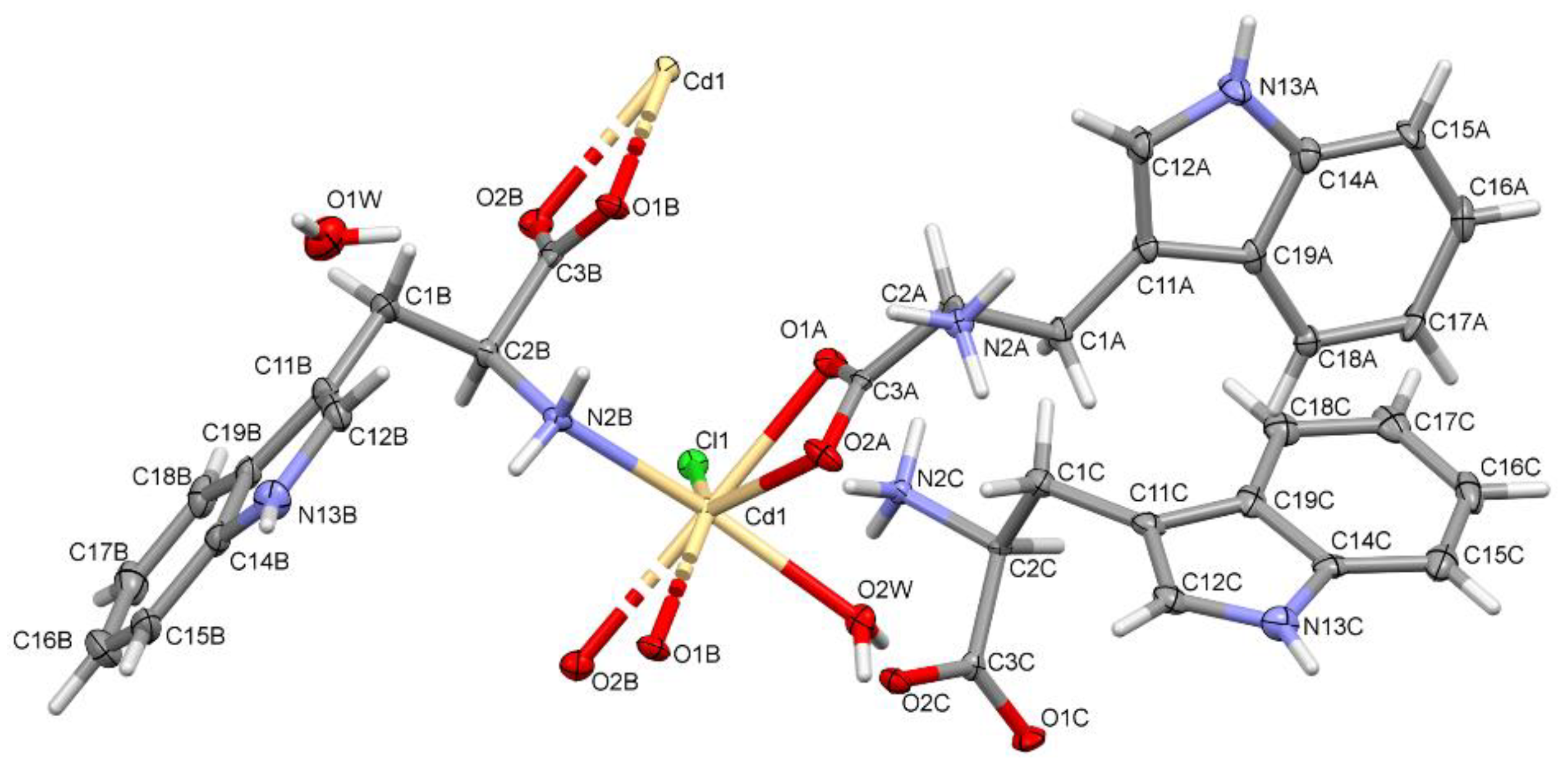
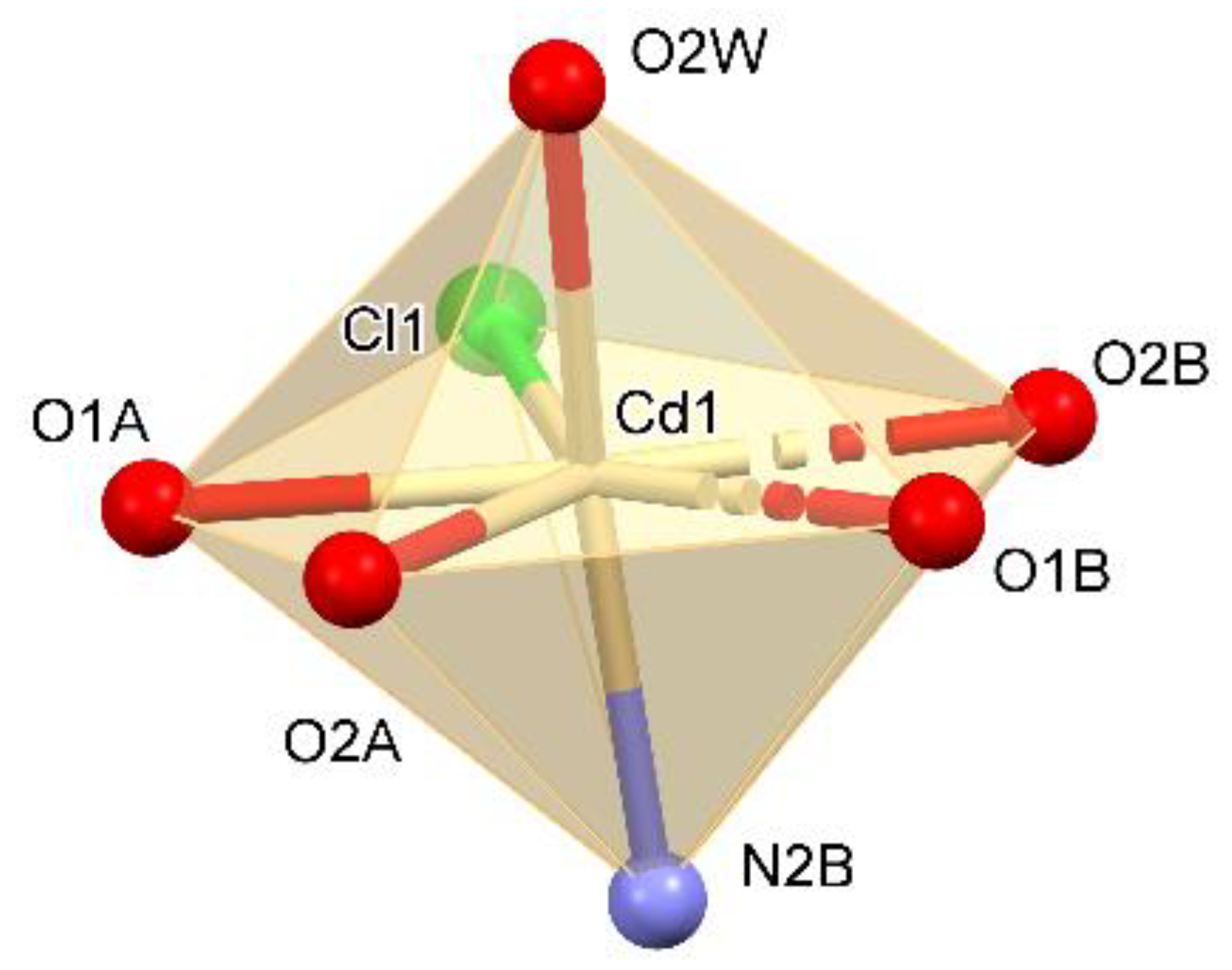


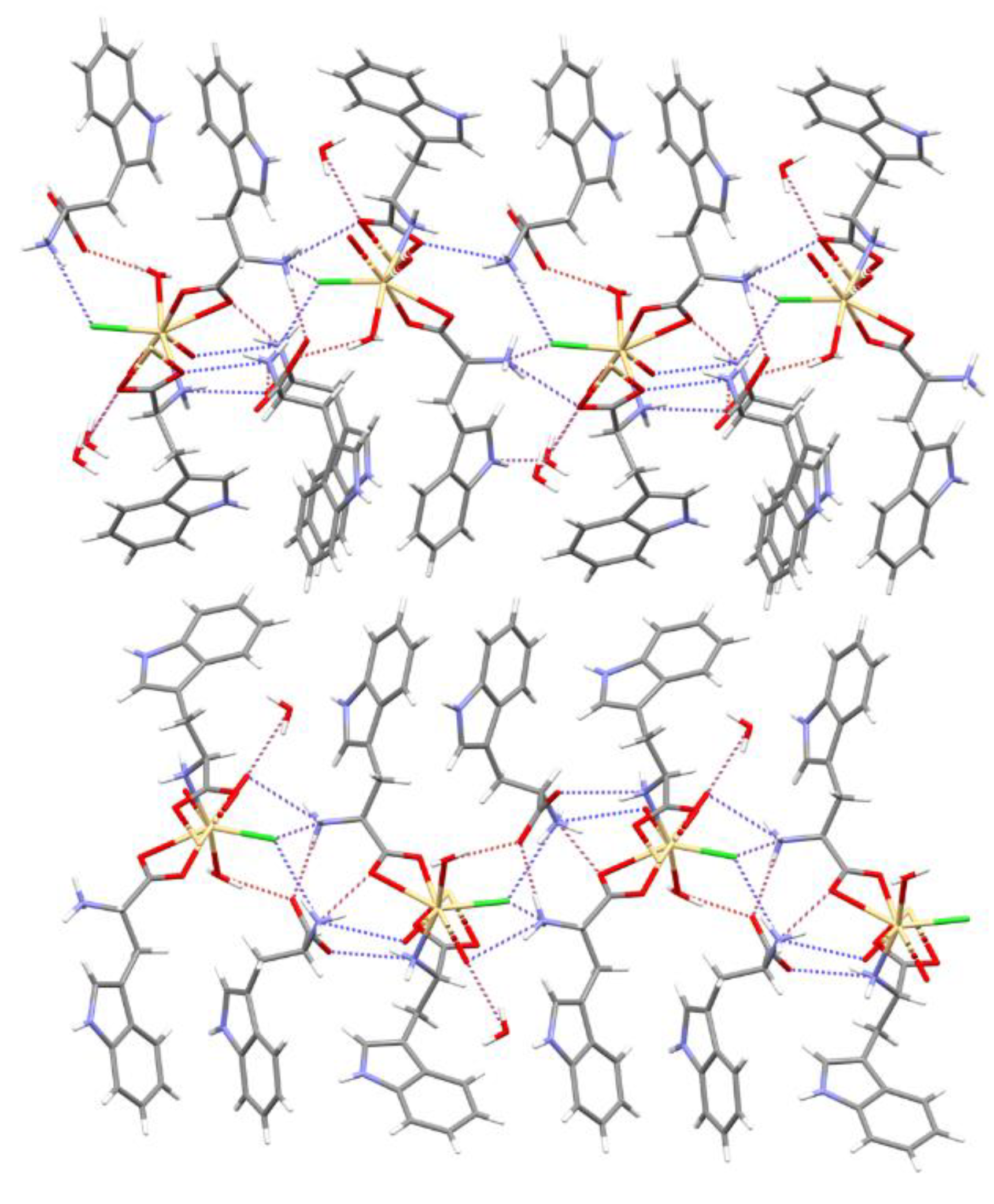
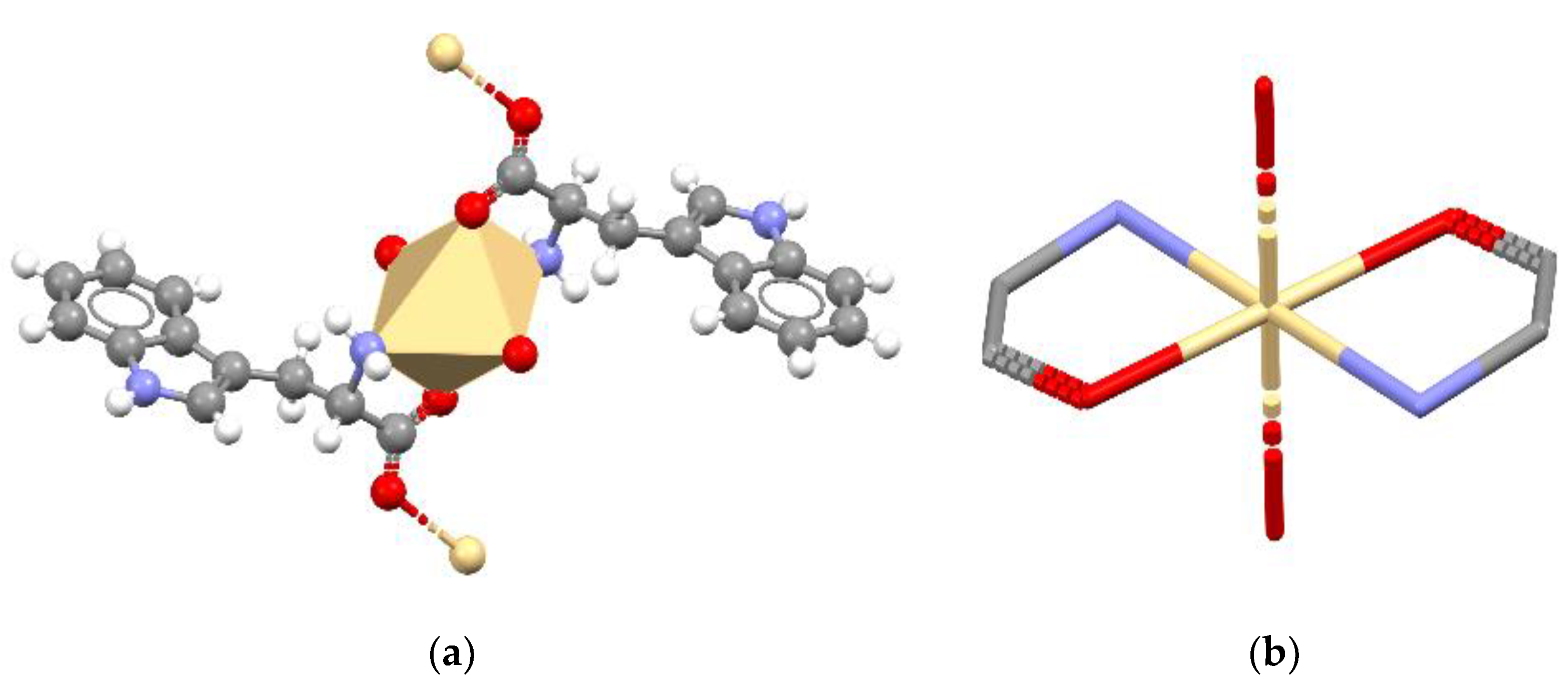

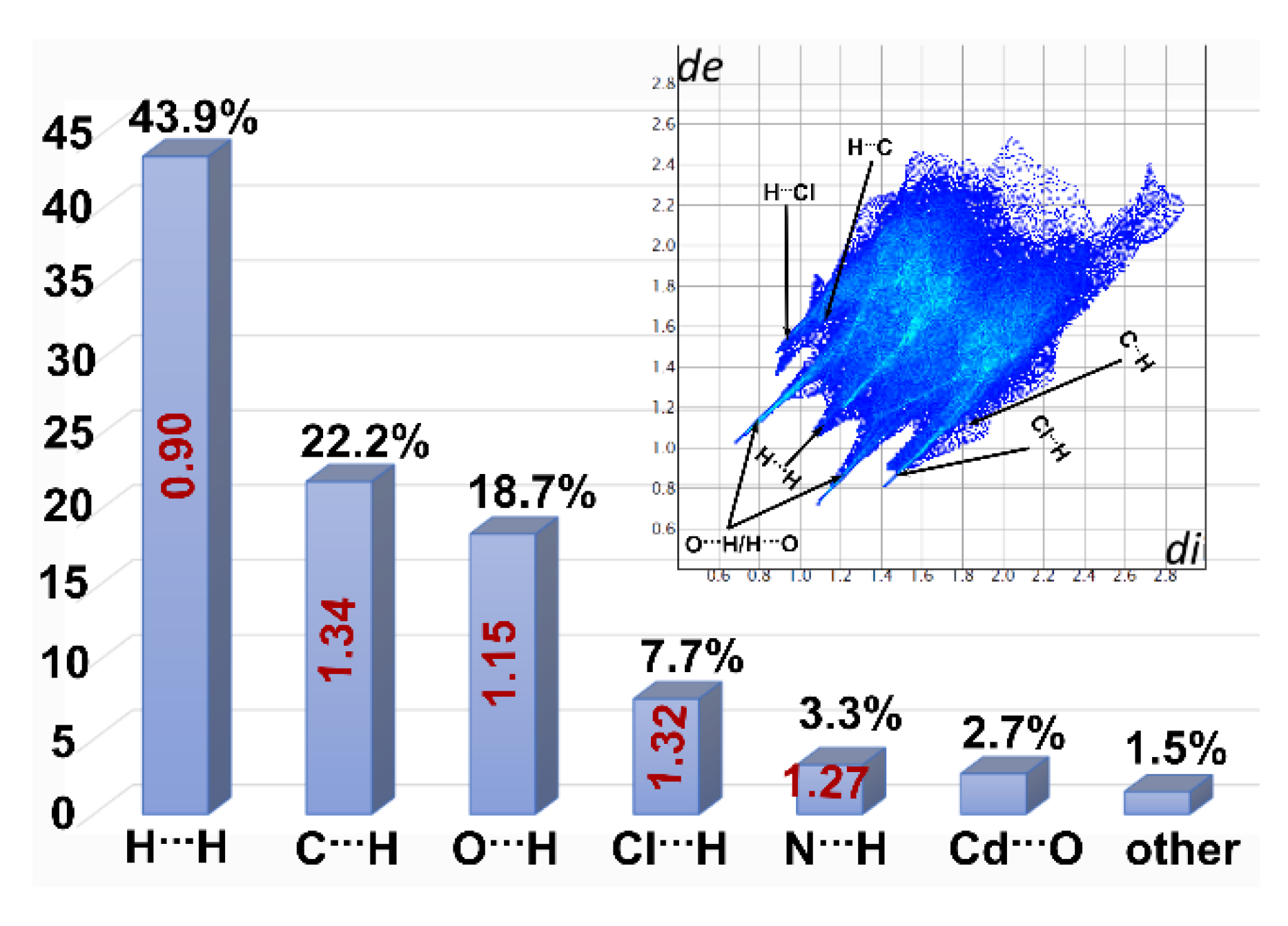
| Crystal Data | |
| Chemical formula | C33H39CdClN6O8 |
| Mr | 795.55 |
| Crystal system, space group | Orthorhombic, P212121 |
| Temperature (K) | 100(1) |
| a, b, c (Å) | 5.5754 (2), 15.7300 (2), 38.2694 (6) |
| V (Å3) | 3356.27 (14) |
| Z | 4 |
| Radiation type | Cu K |
| μ (mm−1) | 6.46 |
| Data Collection | |
| Diffractometer | Rigaku XtaLAB Synergy |
| Absorption correction | Multi-scan |
| No. of measured, independent and observed (I > 2σ (I)) reflections | 13477, 5984, 5729 |
| Rint | 0.052 |
| (sin θ/λ)max (Å−1) | 0.636 |
| Refinement Parameters | |
| R[F2 > 2 (F2)], wR (F2), S | 0.038, 0.096, 1.04 |
| No. of reflections | 5984 |
| No. of parameters | 459 |
| No. of restraints | 6 |
| H-atom treatment | H atoms treated by a mixture of independent and constrained refinement |
| Δ〉max, Δ〉min (e Å−3) | 2.53, −0.86 |
| D—H⋯A | D—H | H⋯A | D⋯A | D—H⋯A |
|---|---|---|---|---|
| N2A—H2AA⋯O2C i | 0.89 | 1.93 | 2.806 (6) | 166 |
| N2A—H2AB⋯Cl1 ii | 0.89 | 2.65 | 3.121 (5) | 115 |
| N2A—H2AB⋯O2B ii | 0.89 | 2.29 | 2.968 (6) | 133 |
| N2A—H2AC⋯Cl1 i | 0.89 | 2.45 | 3.158 (5) | 137 |
| C12A—H12A⋯Cl1 ii | 0.93 | 2.69 | 3.583 (6) | 162 |
| N13A—H13A⋯O1W iii | 0.86 | 2.02 | 2.864 (8) | 167 |
| N2B—H2BB⋯O1C i | 0.89 | 2.19 | 3.010 (6) | 153 |
| N2C—H2CA⋯O2A iv | 0.89 | 2.06 | 2.786 (6) | 139 |
| N2C—H2CA⋯O1B v | 0.89 | 2.40 | 3.059 (6) | 131 |
| N2C—H2CB⋯O1C vi | 0.89 | 1.89 | 2.766 (6) | 167 |
| N2C—H2CB⋯O2C vi | 0.89 | 2.50 | 3.166 (6) | 132 |
| N2C—H2CC⋯Cl1 | 0.89 | 2.35 | 3.227 (5) | 168 |
| O1W—HW2⋯O2B | 0.84 (1) | 2.00 (4) | 2.797 (6) | 157 (9) |
| O2W—H2W⋯O1A vii | 0.84 (1) | 1.95 (2) | 2.783 (6) | 177 (6) |
| O2W—H1W⋯O2C | 0.84 (1) | 1.86 (2) | 2.685 (5) | 167 (6) |
© 2020 by the authors. Licensee MDPI, Basel, Switzerland. This article is an open access article distributed under the terms and conditions of the Creative Commons Attribution (CC BY) license (http://creativecommons.org/licenses/by/4.0/).
Share and Cite
Czylkowska, A.; Szczesio, M.; Pietrzak, A.; Raducka, A.; Rogalewicz, B. Novel Coordination Polymer of Cadmium (II) with L-Tryptophan. Materials 2020, 13, 2266. https://doi.org/10.3390/ma13102266
Czylkowska A, Szczesio M, Pietrzak A, Raducka A, Rogalewicz B. Novel Coordination Polymer of Cadmium (II) with L-Tryptophan. Materials. 2020; 13(10):2266. https://doi.org/10.3390/ma13102266
Chicago/Turabian StyleCzylkowska, Agnieszka, Małgorzata Szczesio, Anna Pietrzak, Anita Raducka, and Bartłomiej Rogalewicz. 2020. "Novel Coordination Polymer of Cadmium (II) with L-Tryptophan" Materials 13, no. 10: 2266. https://doi.org/10.3390/ma13102266
APA StyleCzylkowska, A., Szczesio, M., Pietrzak, A., Raducka, A., & Rogalewicz, B. (2020). Novel Coordination Polymer of Cadmium (II) with L-Tryptophan. Materials, 13(10), 2266. https://doi.org/10.3390/ma13102266






